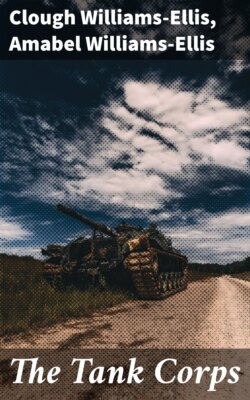Читать книгу The Tank Corps - Clough Williams-Ellis - Страница 10
На сайте Литреса книга снята с продажи.
IV
ОглавлениеTable of Contents
The first scene of Act II. (March to mid-August) was occupied with one of the most dramatic achievements of the War.
This was the manufacture at Lincoln of the first 150 “Land Ships” ordered by the Government, in the space of six months, and in absolute secrecy.
The public discussed the phantom Russians who travelled through England by night. It discussed the Germans who nightly signalled to each other throughout the inland counties. But it did not discuss the large water-tanks or cisterns that were being made for Petrograd, Egypt, or Mesopotamia, or some such place.
That this vital secrecy was kept for months by hundreds of people was chiefly due to the happy effect of copious and imaginative lying.
There was no mystery about these grotesque armour-plated creatures! They were not really for Mesopotamia at all. Every one knew that.
The Russian Government had ordered them. They were ridiculous things? Of course they were. It was a Russian design. Was there not even an inscription in Russian characters on them? At least they might frighten the Germans if they served no other useful purpose.
Tradition relates that when the first drawings were brought to the manager’s office of the factory which had been selected for the manufacture of the “water-carriers,” the manager and his staff expressed themselves as being seriously concerned for the sanity of the designers, and of those who submitted such drawings to practical men like themselves.
They were, however, let into the secret of the real part which Tanks were to play, and though still profoundly incredulous, decided, like good citizens, to carry out whatever work was asked of them. The vital necessity of secrecy having been impressed upon them, they were asked—tradition continues—what arrangements they would like made about sentries and the isolation of their workpeople. After a little consideration they answered that they would only guarantee that the secret should be kept on condition that they were given a completely free hand and not interfered with.
They proposed to have no sentries, no “isolated area” to proclaim trumpet-tongued, “Here is a secret!”
They desired merely to propound a satisfactory system of lies, to give an “alternative explanation”—to put it more delicately—and to carry out their work with a disarming publicity.
After some hesitation the authorities consented to this strange system. We shall see how, on September 15, “wisdom was justified of her children.”
The factory where these curious interviews are reported to have taken place was that of Messrs. Forsters, Agricultural Implement Manufacturers of Lincoln. We almost literally beat our ploughshares into swords.
In London, changes in Tank administration were going on as usual. The trend as far as supply and manufacture were concerned was towards centralisation.
A Tank Supply Department was created at the Ministry of Munitions, and the Tank Supply Committee changed its name to “Advisory Committee of the Tank Supply Department.” In August this Committee—gradually, as it were—turned into the Mechanical Warfare Supply Department before alluded to. Lieutenant (by now Colonel Stern was at its head.)
In the M.W.S.D. were now concentrated three separate functions:
They were Tank designers; they were responsible for supply; they were responsible for the final inspection of machines. The future was to show that such concentration had some drawbacks as well as many obvious advantages.
Note.—The genesis of the “large-wheeled tractor” was as follows: Trenches with a parados and parapet about 4 ft. high were being constructed by the enemy in Flanders.
The engineers consulted by the Land Ship Committee gave it as their considered opinion that if these obstacles were to be crossed, a wheel of not less than 15 ft. diameter would be necessary.
Machines with these gigantic wheels were actually ordered, but the wooden model that was knocked together as a preliminary at once convinced even its best friends that the design was fantastic, and that any machine of the kind would be little better than useless on account of its conspicuousness and vulnerability.
However, the “big wheel” idea did not utterly die, for in the upturned snout of the Mark I. Tank we have, as it were, its “toe” preserved, the track turning sharply back at about axle level, instead of mounting uselessly skyward, as would have been the case had not the old wheel idea been supplanted by that of the sliding track.
